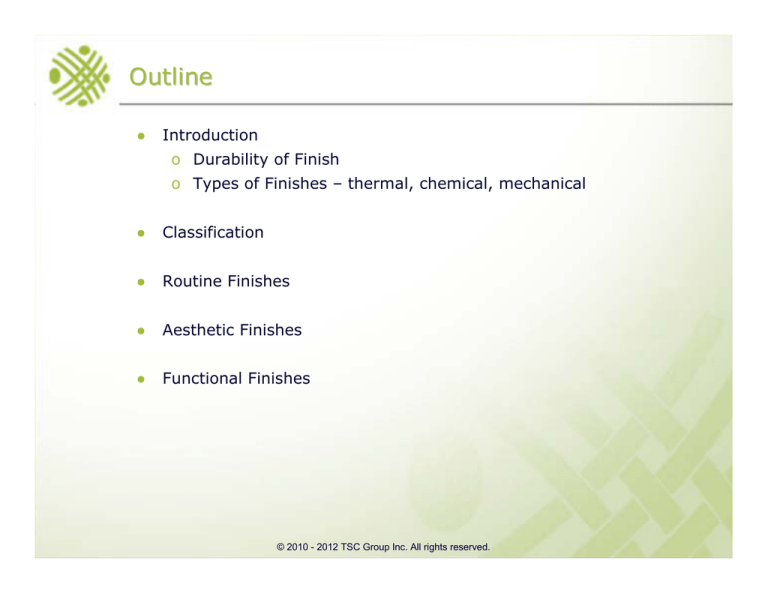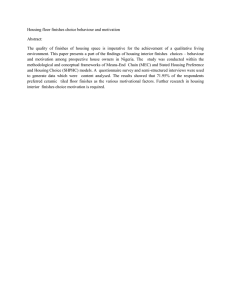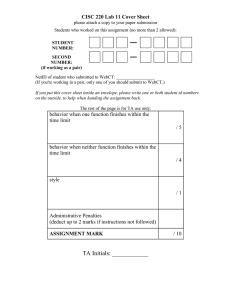
Outline
●
Introduction
o Durability of Finish
o Types of Finishes – thermal, chemical, mechanical
●
Classification
●
Routine Finishes
●
Aesthetic Finishes
●
Functional Finishes
© 2010 - 2012 TSC Group Inc. All rights reserved.
Introduction
●
Finishes are “all the processes through which fabric is passed after
bleaching, dyeing, or printing in preparation for market and use…”
(Source - Dictionary of Fiber & Textile Technology).
●
Most finishes are applied to fabrics; they can also be applied to
fibers, yarns, and products.
●
Finishes are categorized based on:
o Durability - permanent, durable, semi-durable, non-durable
o Application method - thermal, chemical, mechanical
o Purpose – routine, aesthetic, functional
Introduction
●
The following are the durability categories for finishes:
o A permanent finish lasts for the life of the fabric.
o A durable finish lasts for the expected life of the product;
finish effectiveness gradually diminishes after repeated
laundering or cleaning.
o A semi-durable finish loses effectiveness after repeated
laundering and use and must be reapplied.
o A non-durable finish such as starch is partially or completely
removed after one laundering or cleaning.
Introduction
●
In the textile manufacturing process, finishes are classified
according to application method:
o Thermal finish - Heat is applied to thermoplastic materials to
produce a desired effect.
−
Example: permanent pleats in thermoplastic materials
o Chemical finishes - Fabric is chemically reacted with the finish
to produce a desired effect. Application may result in changes in
other properties (tear or tensile strength); chemical finishes are
applied under very controlled conditions.
−
Example: durable press finish
o Mechanical finishes - Fabric is subjected to mechanical action
to produce a desired effect; mechanical and chemical finishes
are combined for some applications.
− Example: napping of flannel fabric
Finishes
Routine Finishes
Sizing
Aesthetic Finishes
Calendered Finishes
Desizing
Embossing
Scouring
Moiré
Bleaching
Glazing & Ciré
Singeing
Tentering
Calendering
Mercerization
Fulling
Beetling
Weighting
Shearing
Schreinering
Abrasive Finishes
Napping & Brushing
Sanding & Sueding
Flocking
Burn-out
Denim Finishing
Plissé
Pleating & Crinkling
Stiffening
Functional Finishes
Moisture Management
Temperature Regulation
Repellent & Release
Wrinkle Resistant &
Durable Press
Antimicrobial
Shrinkage Control
Flame Retardant
Routine Finishes
●
Routine finishes are typically required to prepare woven and
knitted fabrics for dyeing and printing. Routine finishes are also
used to prepare fabrics for sale.
●
Some finishes are applicable for all fabrics; others are for specific
fiber content or fabric construction.
●
Considerable advances have been made toward using
environmentally friendly chemicals and processes.
Routine Finishes
●
Commonly used routine finishes are:
o Desizing – removal of protective starch coating
o Scouring – cleaning
o Bleaching – whitening
o Singeing and shearing- removal of protruding fibers
o Tentering – alignment of yarns in a fabric
o Calendering – pressing
o Mercerization – caustic soda treatment of cotton
o Fulling – shrinkage treatment of wool
Aesthetic Finishes
●
Aesthetic finishes change the appearance and/or hand of fabric.
●
Fiber content and yarn and fabric characteristics determine the
suitability of a finish for the fabric.
●
The following aesthetic finishes are included:
o Calendered finishes – embossing, moiré, glazing, ciré
o Abrasive finishes – napping, brushing, sanding, sueding
o Flocking
o Burn-out
o Plissé
o Pleating
o Denim finishing
Calendered - Embossing
●
Embossing creates texture by giving the
fabric a raised 3D effect produced by passing
the fabric between an etched roller and a soft
surface roller. The design from the engraved
roller is imprinted on the fabric.
o Embossed fabrics made with
thermoplastic fibers are heat set
permanently.
o Embossed fabrics made of cellulosic
fibers are treated with resin to make the
finish durable.
●
Cheaper fabrics resembling plissé are
produced by embossing cotton and cotton
blends. Embossing in place of plissé reduces
cost, but the embossed design is often not as
durable.
Calendered - Moiré
●
Moiré is produced by passing two layers of a
rib weave (e.g., taffeta, faille, bengaline)
fabric between rollers to flatten the ribs.
Flattening the rib in certain areas alters the
way light reflects off the fabric. Terms such as
watermark and wood grain describe the
appearance of moiré fabric.
●
Heat applied during calendering produces a
durable finish on synthetic fiber fabrics with
thermoplastic properties (e.g., acetate,
polyester).
●
Moiré and imitation moiré print finishes are used for drapery,
upholstered furniture, accent cushions, and formal dresses.
●
Less expensive plain weave fabrics are printed with a moiré pattern to
reduce cost.
Calendered - Glazed and Ciré
Glazing is produced by applying starch, wax, or resin prior to passing
the fabric through very smooth rollers moving at high speed. The
rollers add luster by flattening the fabric surface. The finish is
temporary with starch or wax, and durable with resin.
o Glazed finishes are used for woven cotton fabrics. The level of
gloss or shine varies.
o Examples: glazed chintz and polished cotton
Calendered - Glazed and Ciré
● Ciré finishes are used for fabrics woven with thermoplastic fibers.
The fabric is passed through high-speed, heated rollers that soften
and polish the surface, creating a “wet look.”
o Ciré means "wax" in French.
o Ciré is used for items such as backpacks, sleeping bags, and
outerwear.
face
back
Abrasive Finishes - Napping
●
Napping is a mechanical finish where wire hooks are used to pull fibers
from low twist yarns to produce a raised fabric surface.
o Fabric can be napped on one or both sides of the fabric.
o Napped fabrics can be produced only with spun yarns as fiber ends
cannot be pulled from filament yarns.
Magnified view
Abrasive Finishes - Napping
●
Worsted flannel, used for suits and coats, is made by napping fabrics
woven with worsted wool.
face
back
Abrasive Finishes - Napping
●
Outing flannel is a soft, cotton plain or twill weave fabric napped on
both sides for sleepwear, children’s clothes, and men’s cold weather
shirts.
face
back
Abrasive Finishes - Napping
●
Flannelette is a soft, cotton plain weave fabric napped on one side
for pajamas, sheets, and diapers.
face
back
Abrasive Finishes - Napping
●
Fleece is produced by napping weft knit fabrics such as French terry.
not napped
napped
Abrasive Finishes - Brushing
●
Brushing is a mechanical process that gently raises the fibers
from the surface. It is also part of pile manufacturing, used to
remove short fibers from the surface of the fabric.
Abrasive Finishes - Sanding and Sueding
●
Sanding and sueding are mechanical finishes that alter the fabric
surface. For both, the fabric passes between rubber pressure rollers
and over an abrasive cylinder(s). Particles loosened from the fabric
surface are removed with a brush.
o Sanding, used for silk fabrics, gives fine fabrics a soft hand.
o Sueding gives fabrics a suede-like effect.
cylinder with an abrasive surface
Flocking
●
Flocking is a raised fiber finish or design where short fibers, or
flock, are attached with an adhesive applied to the fabric surface.
●
Fabric, adhesive, adhesive application method, flock characteristics
and flock application method are major factors that affect the
performance and cost of flocked fabrics. The end use of the flocked
fabric determines the appropriate materials and application
techniques.
●
To create flocked designs, an engraved roller or rotary screen is used
to print the fabric with an adhesive to which the flock fibers are glued
to create a design.
●
For a velvet-like effect, the entire fabric surface is coated with an
adhesive and flock fibers.
o Short, random-cut fibers are used for decorative and packaging
materials.
o Precision-cut fibers are used for apparel, blankets, and upholstery
fabrics.
Burn-out
●
Burn-out design is produced by dissolving one type of fiber in a
fabric that is manufactured with two fibers.
●
Burn-out finish can be used only for combination yarns or fabrics
where one fiber is easily dissolved by a solvent or an acid, and the
other is resistant to that chemical.
o Acetone is commonly used to dissolve acetate fibers from
combination yarns and fabrics, and sulfuric acid is employed to
dissolve cellulosic fibers such as rayon.
o Polyester and silk are often used as fibers that are resistant to
solvents and acids.
●
The appearance of burn-out finishes depends on fabric
construction:
o In flat fabrics, burn-out is characterized by a sheer area with
fringe around the edge of the sections where the chemical was
applied.
o In velvets, the design is created by dissolving the pile in certain
areas; thus, the base fabric is visible. The raised design may
resemble that of flocked fabrics.
Plissé
●
Plissé fabric is produced by
applying a chemical in vertical
stripes that shrinks those areas of
the material.
●
Shrinkage creates a puckered look
similar to that of seersucker fabric,
but in a much less expensive
manner than the slack tension
weaving used in making
seersucker.
●
Sodium hydroxide or caustic soda
paste is used to shrink cotton
fabrics. Phenol is used to shrink
nylon fabrics.
Pleating
●
Pleating is a mechanical finish combined
with a thermal or chemical process to make
the finish permanent.
●
The size and shape of pleats range from
simple knife or box pleats to novelty
scalloped pleats to random pleated designs.
●
The method for pleating depends on factors
such as fabric, desired look and fiber
content.
o Thermoplastic fibers can be heat set to
produce permanent pleats. Acetate, a
thermoplastic fiber, cannot be heat set.
o Resin is used for cotton and cotton
blends.
Crinkling
●
Crinkling is one method of producing
fabrics with crinkled or crushed
appearance.
o Fabrics as well as finished
products are crinkled.
●
Different methods are used to
mechanically distort the fabric to
create the crinkled or crushed fabric
appearance.
●
Based on the fiber content, the fabric
is typically either heat set or treated
with resin and cured.
Stiffening Finishes
●
Stiffening finishes include non-durable finishes such as starch
and durable finishes such as acrylic emulsions.
o Stiffening finishes are used for crinoline so it retains its stiffness
after laundering.
o Parchmentization of cellulosic fibers stiffens the fabric. Organdy
is produced by parchmentization of lightweight, cotton fabric.
Denim Finishing
●
Denim finishing includes several dry and wet processing
techniques that give garments a used, worn, vintage, lived-in, or
distressed look.
o Wet processing techniques include rinsing (water washing),
stone washing, chemical washing (acid wash, bleaching),
tinting, and over dyeing. Enzymes may reduce the time
required to achieve the desired look.
o Dry processing techniques, or abrasive finishes, include hand
sanding, sandblasting, brushing, destruction (holes, tears),
laser burning, and laser discharge.
●
Dry processes are applied to specific areas rather than a whole
garment. Robotic machines are used for labor-intensive finishing
techniques such as hand sanding.





